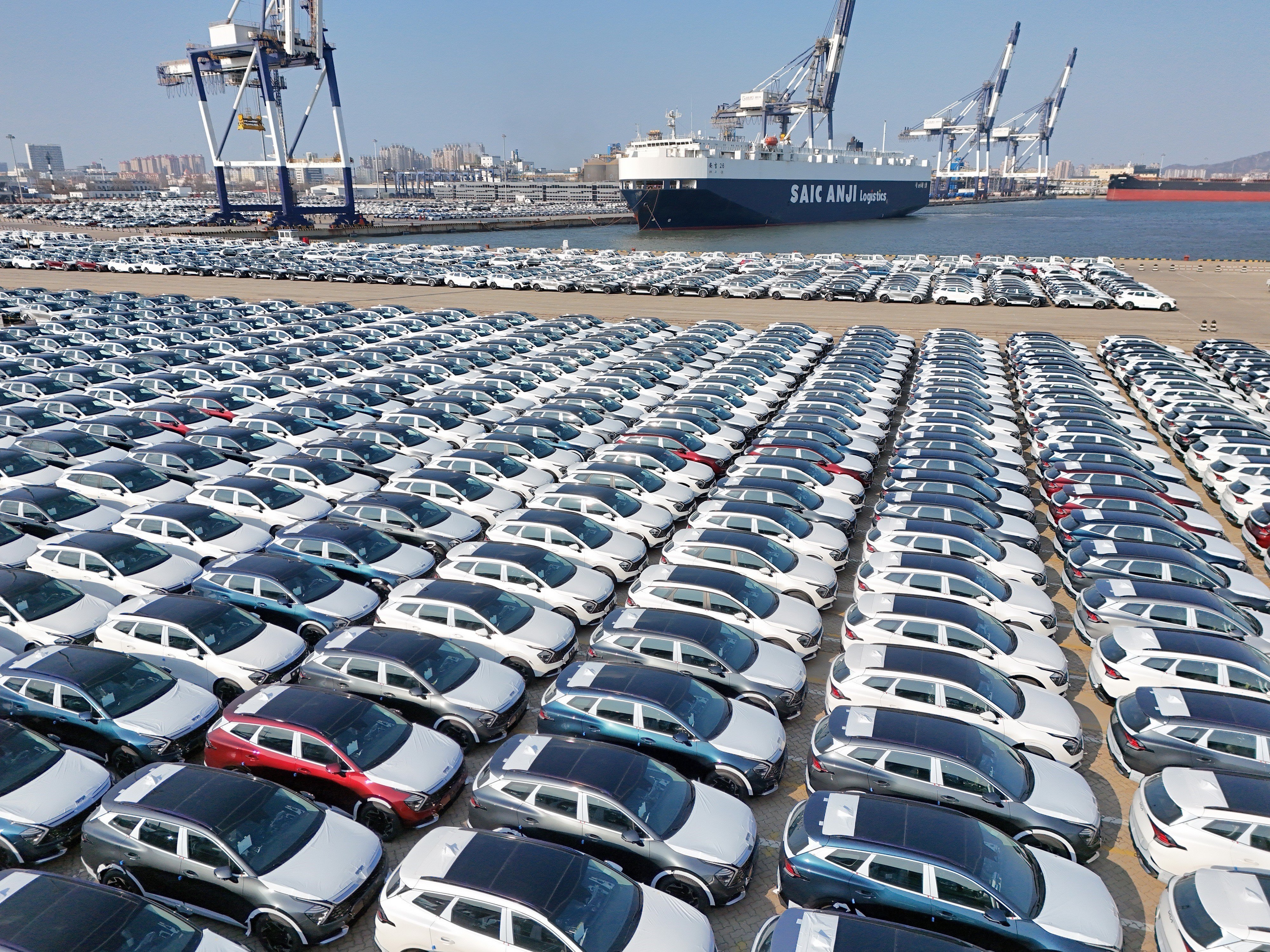Double-digit growth experiences from countries around the world
In the context of an increasingly volatile and competitive global economy , double-digit economic growth - that is, a GDP growth rate of over 10% per year - has become a strategic goal and aspiration of many countries, especially developing economies . High growth not only helps to rapidly expand the scale of the economy , facilitate capital accumulation and increase investment resources for essential areas such as education, health, infrastructure and defense, but also reflects national governance capacity and competitive strength in the international arena. For countries with large populations and low levels of development, double-digit growth is an important tool to help narrow the development gap, escape the "middle-income trap" and create the premise for sustainable development. The lessons of some countries below need to be shared:
First, the active role of the state in guiding and intervening in economic development is a key factor in fast-growing countries such as Japan, South Korea, Singapore and China. The highlight of these countries is the clear presence of the “developmental state” model. Accordingly, the state not only builds the institutional framework but also proactively coordinates resources, plans long-term development strategies, orients priority sectors and implements selective protection, while supporting businesses in technological innovation and improving competitiveness.
Japan maintained an average GDP growth rate of over 10% during the period 1960 - 1973, with 12.1% in 1964 and 11.8% in 1965, thanks to the Government's strategic orientation of spearhead industry development. The high national savings rate of over 30% created large financial resources for public and private investment. The Japanese government actively participated in industrial planning, protected key industries and coordinated with businesses in developing new technologies (1) .
Similarly, from the mid-1960s to the late 1970s, South Korea achieved a GDP growth rate of 9-10% per year, with many years above 12%, peaking at 14.9% in 1973. The South Korean government oriented its preferential credit policy, focusing on supporting large corporations (chaebol) such as Samsung and Hyundai, creating conditions for these corporations to lead the national economic development (2) .
Singapore is also a typical example with a continuous growth rate of over 10% from 1967 to 1978, peaking at 15.5% in 1973. Singapore's "corporate state" model maximized its effectiveness through attracting foreign investment, developing trade and logistics infrastructure, and building a transparent and efficient administration (3) .
China maintained GDP growth of over 10% during the period 1992 - 2007, with 14.2% in 1992 and 2007, thanks to the State's role in both guiding and flexibly applying market mechanisms in economic reform, creating a favorable environment for the private sector to develop (4) .

Thus , the state's role in guiding, creating and actively intervening, demonstrated through planning long-term development strategies, selectively protecting priority industries, supporting technological innovation and building a favorable institutional environment, is a core factor for rapid and sustainable growth.
Second, deep economic structural transformation towards export-oriented industrialization is a common feature of high-growth countries. This process includes a strong shift from an agricultural economy to an industrial and service economy, and from a closed economic model to a deep global integration.
Korea focuses on developing high value-added manufacturing industries, boosting industrial exports and increasing the proportion of industry in GDP. A typical example is the transformation of chaebols into large corporations, creating outstanding export power. Singapore develops high-quality logistics and financial services to serve the open economy. China, with its reform and opening-up strategy since 1978, has rapidly industrialized and urbanized, becoming the "factory of the world" with a sharp increase in export value. Average double-digit growth over 15 years has made China the second largest economy in the world.
Third, technological development and innovation are key breakthroughs in economic growth. Experiences from Japan, South Korea and China show that breakthroughs are associated with the ability to “break through the technological ceiling”. During its high-growth period, Japan shifted from traditional mechanical manufacturing to the development of first-generation semiconductor technology and information technology, creating a foundation for a thriving electronics industry. South Korea and China continue to promote innovation as they move from basic generations of semiconductor technology to second-generation technology, including artificial intelligence (AI), digitalization and other high technologies. These advances not only improve labor productivity but also help countries maintain their competitive advantage in a rapidly changing global economic context. Strong investment in research and development, building a favorable environment for innovation, together with close links between science, technology and production, are indispensable factors to ensure sustainable economic growth.
Fourth, investing in human resources and building quality educational institutions are important foundations for double-digit growth . Human resources and educational institutions play a decisive role in building production and innovation capacity. Japan and South Korea stand out for developing a mid-level technical workforce while maintaining a long-term employment model with enterprises, contributing to improving productivity and production quality. Singapore focuses on building a high-quality education system and implementing a strict talent selection policy, integrating human resource training for the public sector and high-end service industries. Meanwhile, China takes advantage of its young, low-cost workforce and invests heavily in technical education, creating favorable conditions for the development of large-scale and diversified manufacturing. Human resource development policies associated with educational innovation, vocational training, and building a disciplined and professional work culture are key factors contributing to the success of these countries.
Fifth, political stability and improved institutional environment are key factors for fast-growing countries . These countries maintain high political stability and continuously improve their institutional environment to build strong confidence for investors and businesses.
Botswana is a typical example in Africa, a region that often faces political instability. However, Botswana has maintained political stability, transparent budget management and strict enforcement of the rule of law, thereby creating a solid foundation for double-digit economic growth in the 1970s, reaching a rate of 26.4% in 1972 (5) .
Political stability facilitates the formulation and implementation of long-term economic policies, protects property rights and encourages private investment. This is an indispensable factor for maintaining sustainable economic growth.
Sixth, effectively exploiting the international context and external opportunities is an important factor contributing to promoting rapid growth. Strongly growing countries all know how to exploit the conditions and opportunities from the international environment. Japan recovered quickly after the war thanks to US aid and expanded export markets (6) . South Korea benefited from the political-military alliance with the United States, taking advantage of capital and technology transfer (7) . China exploited the wave of globalization, attracted foreign investment and actively participated in the global value chain. Botswana knows how to turn diamond resources into a driving force for development through transparent governance and sustainable economic strategies. The ability to flexibly adapt to the international context and make good use of external opportunities is a key factor helping countries overcome challenges and maintain high growth over a long period of time.
In addition to common points, each fast-growing country has its own unique characteristics. Japan stands out with its “behind but ahead” strategy, focusing on developing high technology and building a business model that closely connects workers and business owners. China has succeeded thanks to its large population, flexible land policies and a decentralized administrative system that competes between localities. South Korea has effectively promoted the chaebol model, focusing resources on large corporations as economic locomotives. Singapore takes advantage of its position as an international logistics and financial center, taking high-quality services as a pillar of development. Botswana is a rare example of effective resource management, avoiding the “resource curse” and maintaining stability and sustainable development in the African region (8) .
From the above experiences, it can be affirmed that rapid and sustainable economic growth cannot rely on luck or natural advantages alone, but requires a harmonious combination of clear strategic vision, effective development institutions, strong investment in human resources and the ability to flexibly adapt to the international context. In particular, growth needs to be shifted from quantitative to qualitative development, through improving labor productivity, innovation and ensuring social equity. Otherwise, high growth rates will be difficult to maintain and can easily lead to socio-economic crises in the medium term.
Current status and potential of double-digit economic growth in Vietnam
Vietnam has undergone a turbulent economic development journey and profound transformation over the past nearly four decades, from a centrally planned economic model to a socialist-oriented market economy. This process has been marked by different growth stages, reflecting the operation of the renovation policy, the ability to respond to global economic shocks and the country's strategic development orientation.
In the early post-renovation period (1985 - 1989), Vietnam's economic growth rate was still quite modest, ranging from 2.79% to 5.14%, due to the heavy impact of the economic crisis, high inflation and the shortcomings of the centralized planning model. However, after efforts to reform institutions and open the market, the economy began to show clear signs of improvement in the 1990s. In 1995 and 1996, GDP growth rates reached 9.54% and 9.34% respectively - the highest levels in our country's modern economic history (9) . This was also the period that marked the initial success of institutional reform policies and regional trade integration, when Vietnam joined ASEAN in 1995 and strongly attracted foreign investment flows.
The period of 1990 - 1997 was a period of continuous high growth, reflecting the effectiveness of the policy of transforming the economic model, opening up trade, attracting investment and promoting industrial production. However, after 1997, Vietnam was clearly affected by the Asian financial crisis, causing the growth rate to decrease, fluctuating at 6-7% in the period of 1998 - 2007 (10) . This was also the period when Vietnam focused on accumulating institutions, consolidating the foundation of a socialist-oriented market economy, and expanding international integration.
The period 2008 - 2013 continued to pose challenges to economic recovery as Vietnam was affected by the global financial crisis. Growth dropped sharply to 5.66% in 2009, the lowest level in many years (11) . However, in the following years, Vietnam demonstrated efforts to stabilize the macro economy, control public debt, restructure the economy and improve the business environment. By the period 2015 - 2019, Vietnam's economy recorded a clear recovery with a growth rate of 7.47% in 2018 and 7.36% in 2019, thanks to strong reform policies, promoting deep international integration and launching the digital transformation process (12) .
However, the COVID-19 pandemic since 2020 has severely impacted the Vietnamese economy, causing a significant decline in growth. In 2020, the growth rate reached only 2.87%, and in 2021 it was even lower, only 2.56% - the lowest level in more than three decades (13) . This is the result of many adverse factors such as supply chain disruptions, travel restrictions, and declining domestic and global consumer demand.
2022 marked a strong recovery with a growth rate of 8.02%, thanks to the economic opening policy, financial support packages and the growth of domestic consumption demand. However, in 2023, the economy slowed down with a growth rate of 5.05%, due to inflationary pressure, international market fluctuations and geopolitical tensions (14) .
Analysis of quarterly growth data for the period 2019 - 2023 shows large fluctuations with many consecutive shocks. Specifically, the third quarter of 2021 recorded a record negative growth rate (-6.02%), while the third quarter of 2022 skyrocketed to 13.71%, thanks to low base effects and effective economic recovery policies (15) . These fluctuations reflect the high sensitivity of the Vietnamese economy to global shocks and rapid changes in short-term economic cycles.
In 2024, Vietnam faces many challenges in the context of a global economic downturn, a slowdown in foreign direct investment flows, and rising production costs due to strong fluctuations in energy and input material prices. However, efforts to flexibly manage the macro economy, control inflation, promote consumption and public investment have helped maintain growth momentum. The GDP growth rate in 2024 reached 5.05%, showing that the economy has maintained relative stability but has not yet achieved the expected recovery level (16) . This shows that Vietnam's economy is in a transitional period after recovery, requiring the implementation of longer-term and structural policies to improve labor productivity, promote innovation and promote sustainable growth momentum from the private sector.

Looking back over nearly 40 years of implementing the renovation process, Vietnam only had two years, 1995 and 1996, when GDP growth rates nearly reached the double-digit threshold (9.54% and 9.34%, respectively), but did not surpass this threshold. At the same time, the average growth trend has shown clear signs of decline over 10-year cycles, from about 7.6% in the period 1991 - 2000 to about 6.2% in the period 2011 - 2020. This trend poses a great challenge when Vietnam sets a target of double-digit growth in the near future. The question is, on what basis can Vietnam reverse the current deceleration trend and create a double-digit growth leap in the coming period, especially when the global economic environment is forecast to be full of difficulties, fluctuations and risks?
After nearly 40 years of renovation, Vietnam has witnessed fundamental changes in the context of the world undergoing a breakthrough in technology and digital transformation. The Fourth Industrial Revolution and the complex fluctuations of globalization, under the impact of increasing protectionism, have deeply restructured the global economy. Resources, especially human and financial resources, have shifted strongly, while increasing competition in exploiting and effectively using scarce strategic resources. Protecting and promoting these resources has become an important task of each country in the new era.
The world has entered the era of globalization and knowledge economy with rapid shifts in economic structure, opening up opportunities for leapfrogging development for latecomers. The process of transferring modern technology is taking place at an unprecedented speed, helping Vietnam to "overcome the traditional development sequence", approach and develop high-tech industries without having to go through all the traditional stages of industrialization. The advantage of not having to bear much of the old "industrial heritage" helps Vietnam easily receive and quickly develop key economic sectors.
Vietnam possesses many unique strategic advantages, demonstrated through its deep integration with the world economy, contributing to bringing the country into a new era of development. General Secretary To Lam pointed out seven strategic orientations to bring the country forward in the new era, including: Improving the Party's leadership method; strengthening the Party spirit in building a socialist rule-of-law state; streamlining the apparatus; digital transformation; fighting waste; improving the quality of cadres and economic development (17) . This is both a strategic viewpoint and a fundamental solution to ensure the development process in the right direction and to achieve the set goals.
The strategy for developing the marine economy with a new vision expands opportunities to exploit the enormous potential of the sea and ocean, contributing to improving the country's competitiveness in the international arena. As a latecomer with a low starting point, Vietnam has the advantage of quickly receiving scientific and technical achievements, high technology, investment capital, markets and modern management from developed economies at lower costs. Effectively exploiting these conditions is an important premise to promote rapid and sustainable economic development.
However, the Vietnamese economy is still operating below its potential, especially in allocating and using resources effectively. There is still a lot of room for growth if economic processes are reorganized and domestic and foreign resources are better mobilized and used. The previous growth process mainly relied on increasing the number of input factors, while shifting to growth based on improving quality, efficiency and innovation will bring about comprehensive and sustainable improvements.
Human resources are Vietnam’s fundamental and long-term advantage, especially in the context of a modern economy that is people-centered, based on intelligence and creativity. Focusing on developing high-quality human resources will create a strong driving force to promote innovation and improve labor productivity.
In terms of geopolitics, geo-economics and geo-culture, Vietnam holds an important strategic position in Southeast Asia and the Mekong Sub-region, expanding the potential for inter-regional economic development and promoting deep integration with the region and the world. When properly utilized, these advantages are the basis for Vietnam to become an "explosive" point of economic development in the region.
Vietnam's development momentum is also clearly demonstrated through synchronous innovation and comprehensive development strategy. Four important resolutions of the Politburo, including: Resolution No. 57-NQ/TW, "On breakthroughs in science and technology development, innovation and national digital transformation"; Resolution No. 59-NQ/TW, "On international integration in the new situation"; Resolution No. 66-NQ/TW, "On innovation in law-making and enforcement to meet the requirements of national development in the new era"; Resolution No. 68-NQ/TW, "On private economic development", are considered the "four pillars" that create the foundation for a breakthrough in development. These orientations not only improve institutions and promote innovation but also enhance national governance capacity, creating momentum for economic growth in the coming time.
The innovation of the Party's leadership method, focusing on strategic development orientation, perfecting synchronous institutions and effectively controlling power, will enhance national governance capacity, while ensuring social stability in the context of rapid and complex development. The superiority of the Vietnamese socialist regime, with its orientation towards development for the people, ensuring social equity and welfare, is a solid theoretical basis for achieving rapid growth without causing social imbalance or instability. This is the premise for building a balanced development model, harmonizing economic efficiency and social progress, as well as deep integration and strategic autonomy.
In summary, the target of double-digit economic growth is completely feasible, both in theory and in practice, if led by the right development model, dynamic institutions and strong political determination. The biggest challenge now is not the ability to achieve the target, but Vietnam's mettle, vision and capacity to turn opportunities into sustainable development power.
Some solutions for Vietnam's economy to grow by double digits
Through studying the experience of double-digit economic growth of some countries in the world, combined with the assessment of the current situation and growth potential of Vietnam, it can be affirmed that the target of double-digit growth is an urgent practical requirement. This goal aims to shorten the development gap with the leading countries, enhance endogenous capacity and build an independent and self-reliant economy, thereby affirming the country's position in the international arena.
In that context, innovation in the growth model and deep restructuring of the economy have become key tasks to avoid falling into the “middle-income trap” and create a breakthrough in comprehensive development. On that basis, it is necessary to focus on implementing a number of key solutions to realize the goal of double-digit economic growth in the coming period.
Firstly , strongly innovating the growth model is considered the core solution for Vietnam's sustainable development. This transformation requires the economy to shift from relying mainly on increasing the quantity of input factors such as capital, resources and labor to a growth model based on quality, productivity and innovation, in which technology and intellectual human factors play a central role.
This means that human intelligence and creativity become the decisive factor, dominating the entire process of production and economic development. Lessons from high-growth countries such as Japan, South Korea and China show that a solid development institution, along with a technology innovation strategy and a high-quality workforce, are the decisive factors that help these countries achieve high and sustainable growth rates over a long period of time. Vietnam needs to absorb and effectively apply these lessons to gradually improve its endogenous capacity, build an independent, self-reliant economy and flexibly adapt to fluctuations in the global economic environment.
Second, creating new growth drivers, in which institutions play a central role. General Secretary To Lam affirmed that institutions are currently the “bottleneck of bottlenecks” (1 8 ) , requiring a breakthrough in state management thinking, shifting from the model of “state control” to “state regulation when necessary”, so that the market becomes the main driving force for development. Vietnam needs to establish a dynamic and transparent institutional system, creating a favorable environment for innovation and maximizing the strength of economic entities, especially the private economic sector. In addition, effectively assessing and managing natural resources, marine resources and non-traditional resources, along with developing high-tech processing industries, are prerequisites for increasing the proportion of national value added, avoiding dependence on raw resource exports.
Third, developing high-quality human resources is identified as an important axis in the overall development strategy. Vietnam needs to strongly reform the training system, improve training standards according to international standards and focus on developing human resources for strategic industries. At the same time, it is necessary to build an environment that attracts talent, promotes creativity and adaptability to the digital economy. This is a lesson learned from fast-growing countries, where technical human resources and innovation play a key role in promoting growth.
Fourth, building a service-oriented, transparent public administration and transforming the governance model to adaptive governance, with the development mission at the center, is a key solution to improve effectiveness, efficiency and transparency in development management. At the same time, improving state governance capacity at three levels - institutions, policies and professional, flexible administration - will help avoid fragmentation, hinder innovation and be dominated by vested interests.
Fifth, effectively exploiting the advantages of deep international integration, forming breakthrough institutional "points" such as high-tech innovation free zones and specialized free trade zones with superior institutions according to international practices will attract high-quality investment, promote economic restructuring, develop new industries and increase national competitiveness in the global value chain.
Double-digit growth is not only an option but also a necessity to transform the economy from processing to innovation, based on knowledge and technology. The combination of the above solutions, together with the Party's steadfast leadership and social consensus, will create the necessary breakthrough for Vietnam to move towards the goal of double-digit economic growth, building a modern, sustainable and deeply integrated economy./.
------------------------------
(1) See: Chalmers Johnson: MITI and the Japanese Miracle: The Growth of Industrial Policy, 1925 - 1975, Stanford University Press, 1982, pp. 45 - 90; OECD: OECD Economic Surveys : Japan 1965, OECD Press, 1965, pp. 10 - 25; Cabinet Office of Japan: Japan 's High- Growth Postwar Period: The Role of Economic Plans, Government of Japan, 2010, pp. 12 - 20; World Bank: World Development Indicators : Japan Economic Data 1960 - 1973.
(2) See: Alice H. Amsden: Asia's Next Giant: South Korea and Late Industrialization, Oxford University Press, 1989, pp. 55 - 110; Kim, Eun Mee: Big Business, Strong State: Collusion and Conflict in South Korean Development, 1960 - 1990, State University of New York Press, 1997, pp. 30 - 75; World Bank: Korea Economic Report 2019 , World Bank Group, 2019, pp. 12 - 25; IMF: Republic of Korea: Selected Issues, IMF Country Report, No. 07/327, 2007, pp. 15 - 30.
(3) See: Linda Low: The Political Economy of a City-State: Government-Market Relations in Singapore, University Publishing House Oxford, 1998, pp. 80 - 120; William G. Huff: The Economic Growth of Singapore : Trade and Development in the Twentieth Century , Cambridge University Press, 1994, pp. 150 - 185; World Bank: Singapore Economic Monitor 2020 , World Bank Group , 2020, pp. 15 - 30.
(4) See: Barry Naughton: The Chinese Economy: Transitions and Growth, MIT Press, 2007, pp. 200 - 260; World Bank: China 2030: Building a Modern, Harmonious, and Creative High-Income Society . China 2030: Building a Modern, Harmonious and Innovative High-Income Society), World Bank & Development Research Center of the State Council, 2013, pp. 40 - 65; IMF: People 's Republic of China: Selected Issues, IMF Country Report, No. 09/195, 2009, pp. 25 - 50.
(5) See: Christopher C. Clapham: Botswana: Liberal Democracy and the Labor Reserve in Southern Africa . Botswana: Liberal Democracy and the Reserve Force of Labour in Southern Africa), Journal of Modern African Studies, Cambridge University Press, 1982, pp. 225 - 250; World Bank: Botswana Economic Report 1975 , World Bank Group, 1975, p. 10 - 30; Robert A. Rotberg: The Political Economy of Botswana: A Study in Growth and Democracy ( Roughly translated: The Political Economy of Botswana: A Study of Growth and Democracy, University of California Press, 1988, pp. 100 - 140.
(6) See: Michael Schaller : The American Occupation of Japan: The Origins of the Cold War in Asia, Oxford University Press, 1985, pp. 100 - 140
(7) See: Victor D. Cha : Alignment Despite Antagonism: The United States-Korea-Japan Security Triangle , Stanford University Press, 1999, pp. 45 - 70
(8) See: Paul Collier and Anke Hoeffler: Resource Curse and Natural Resources , Oxford University Press, 2009, pp. 120 - 150
(9) See: General Statistics Office of Vietnam: Socio-economic report for the years 1985 - 1996 , Statistical Publishing House, 1997, pp. 45 - 70
(10) See: State Bank of Vietnam : Vietnam Economic Report 1990 - 2007 , Finance Publishing House, 2009, pp. 30 - 60
(11) See: State Bank of Vietnam : Vietnam Economic Report 2008 - 2013 , Finance Publishing House, 2014, pp. 40 - 70
(12) See: World Bank: Vietnam Economic Update 2019: Staying the Course Vietnam Economic Update 2019: Holding the line), World Bank Group, 2019, pp. 10 - 30
(13) See: General Statistics Office of Vietnam : Socio-economic report 2021 , Statistical Publishing House, 2022, pp. 15 - 50
(14) See: World Bank : Vietnam Economic Update 2023 : Navigating Global Uncertainties, World Bank Group, 2023, pp. 10 - 35
(15) See: General Statistics Office of Vietnam : Report on socio-economic situation in the third quarter of 2021 and 2022 , Statistical Publishing House, 2021 - 2022, pp. 5 - 15
(16) See: World Bank: Vietnam Economic Update 2024 : Managing External Shocks and Domestic Challenges, World Bank Group, 2024, pp.10 - 35
(17) Professor, Dr. To Lam: "Some basic contents about the new era, the era of national rise; strategic orientations to bring the country into a new era, the era of national rise", Electronic Communist Magazine , November 1, 2024, https://www.tapchicongsan.org.vn/media-story/-/asset_publisher/V8hhp4dK31Gf/content/ky-nguyen-moi-ky-nguyen-vuon-minh-cua-dan-toc-ky-nguyen-phat-trien-giau-manh-duoi-su-lanh-dao-cam-quyen-cua-dang-cong-san-xay-dung-thanh-cong-nuoc-vie
(18) Dr. Tran Van: "Overcoming bottlenecks, building development institutions", Nhan Dan Electronic Newspaper , January 23, 2025, https://nhandan.vn/vuot-qua-diem-nghen-xay-dung-the-che-phat-trien-post857173.html
Source: https://tapchicongsan.org.vn/web/guest/the-gioi-van-de-su-kien/-/2018/1111702/tang-truong-hai-con-so---kinh-nghiem-tu-mot-so-quoc-gia-tren-the-gioi-va-giai-phap-cho-viet-nam-%C2%A0.aspx







































































































Comment (0)